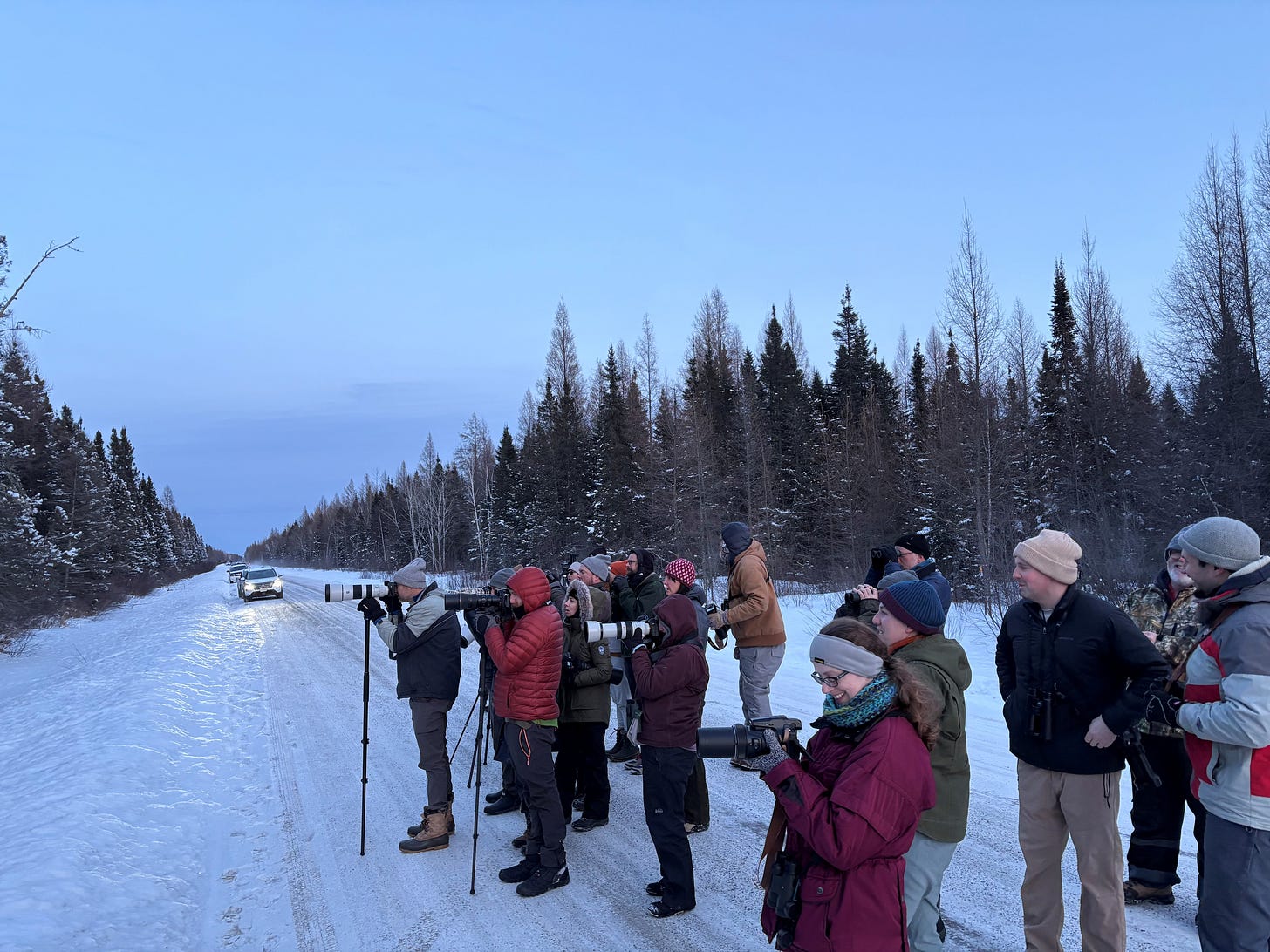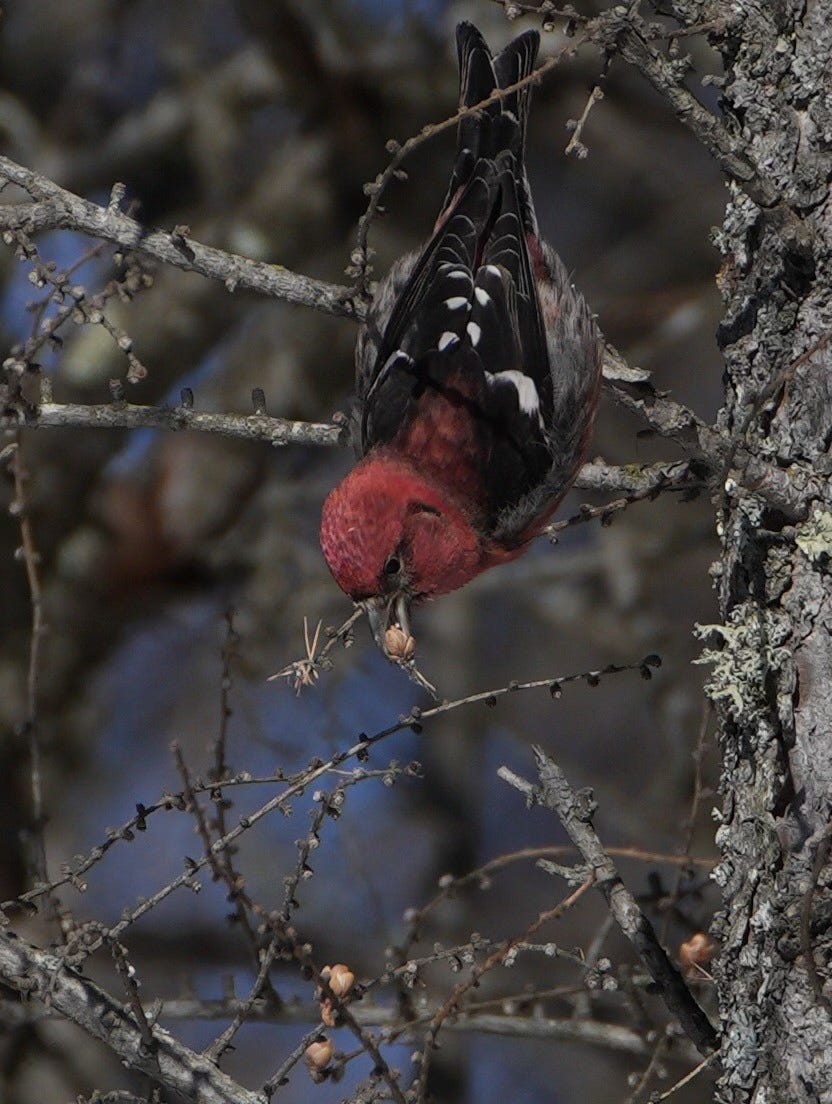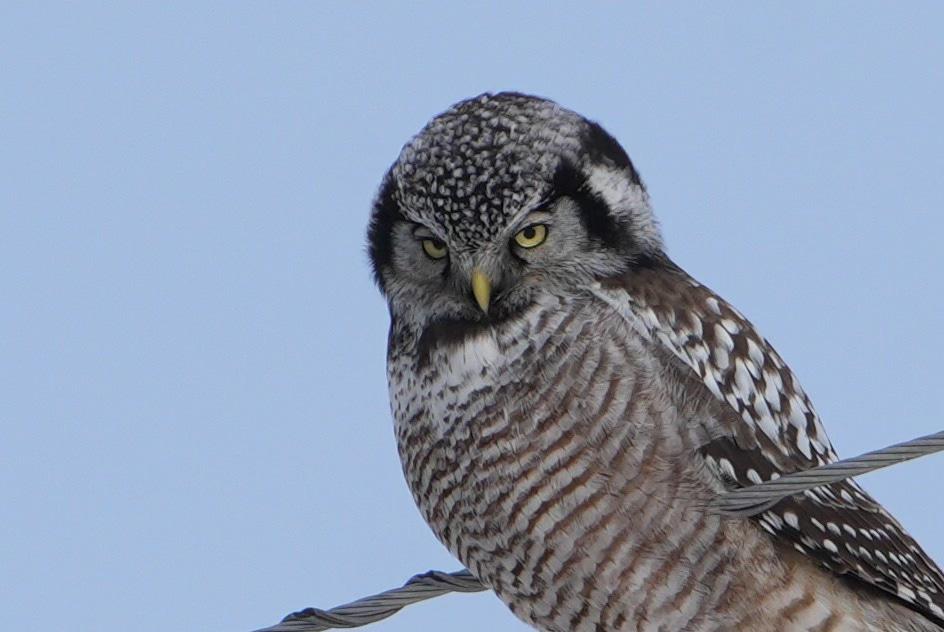1. Let's start with musings on Flaco (the owl that captivated New York): I studied the space that was Flaco’s home for twelve years. Three dead trees that my not-always-reliable phone app identified as an Indian almond, bagpod and common fig, served as his perches. An illustration covered the back of the cage, a misty painting of foggy mountains and steppes with a river running through it, Flaco’s native habitat, put there, if you were in a certain dark mindset, almost to taunt him. The steel mesh that had covered the opening was gone, the former cage now completely open. I asked the zoo worker about this, and he said, “They left it open all year just in case the owl wanted to come back.” As it turned out, he did not. (via Salon Magazine)
2. This one person makes a huge difference - the Greater Adjutant and the "Hagila Army": Purnima Devi Barman remembers the day her life changed. It was 2007, and she got a call that a tree, home to a family of greater adjutant storks, was being chopped down in India’s Assam state, where she lives. When Barman arrived, a nest of endangered baby storks was on the ground. Shocked, she asked the man who cut down the tree: Why would you do this? He told her the bird is a bad omen, a pest, a disease carrier. The stork is locally known as hargila, or bone swallower, because of its tendency to be found near garbage dumps. Her neighbors were angry at her for questioning the man’s actions. “For the first time, I felt the importance—the call of nature,” she says. “From that day, my mission started.” (via Time Magazine)
PFF - By Sharon Dounce, Birders in Sax-Zim - Sax-Zim Bog, Meadowlands, MN
(Pictures From Friends).
3. Trouble in Uganda - the beautiful Grey Crowned-Crane faces a serious threat: With its distinctive golden crown, red throat pouch and slender black legs, the crested crane is beloved in Uganda - featuring on the East African nation's flag and coat of arms. All the country's national sports teams are also nicknamed after the iconic bird, but in recent years it has gone into decline and conservationists say it may face extinction if more is not done to protect it. The bird is protected by law - it stipulates a life sentence and/or a fine of 20bn Ugandan shillings ($5m; £4m) for those found to have killed one. Going back centuries, local Buganda cultural superstition also protected the elegant fowl, which was seen as a symbol of wealth, good fortune and longevity. It was believed that if one killed a crane, its kith and kin would flock to the killer's home, hold vigil and mourn by collectively honking until the person went mad or even died. (via BBC)
4. Turns out at least some hummingbirds (maybe not the ones at your feeder) can "just get a long": Hummingbirds are tiny and delicate, but don’t be fooled: They are among the most aggressive birds in the avian kingdom. Their territorial fury is especially aimed at other hummingbirds. Competition over a patch of flowers or a mate often results in high-speed aerial chases, divebombing and beak jousting. So when Gustavo Cañas-Valle, an ornithologist and birding guide, stumbled across a cave full of hummingbirds nesting and roosting together in Ecuador’s High Andes, he could hardly believe it. “I thought, ‘This looks like a colony,’” Mr. Cañas-Valle said. He added, “They were like bees.” (via The New York Times)
5. Wait! Romeo might be Juliet? Well, its "...interesting and complex": White-throated Sparrows are quite remarkable. If we were to assume that the brighter bird in each breeding pair is the male, we’d be right only half the time. In about 50 percent of breeding pairs of White-throated Sparrows, the brighter bird has the testes and the drabber bird has the ovaries, in keeping with the typical songbird pattern. In the rest of the breeding pairs, however, the bird with the more striking plumage is the one with the ovaries, and the duller bird has the testes. (via Scientific American)
6. Trio of research papers point to birds and mammals developing similar cognitive abilities via different evolutionary paths: The New Caledonian crow can lay claim to being one of the world’s cleverest birds. It can put two sticks together to make a rod to “fish” for food. The corvid’s dazzling propensity for strategic planning and problem-solving mirrors the cognitive skills of some great apes. Observations like these have stoked a decades-old debate about whether birds and mammals enjoy a shared cognitive legacy from a common ancestor, which lived more than 300mn years ago — or whether their skillsets evolved separately. Now, research points to the latter, with birds and mammals developing similar cognitive abilities independently, via different evolutionary paths. (via Financial Times)
PFF - By Sharon Dounce, White-winged Crossbill - Sax-Zim Bog, Meadowlands, MN
(Pictures From Friends).
7. We knew this intuitively but maybe not some of the details: Today, scientists with the National Audubon Society published research in Nature Ecology & Evolution that will help inform global efforts to protect migratory birds. In the study, Multispecies migratory connectivity indicates hemispheric-scale risk to bird populations from global change, researchers propose a new way to measure risk and identify where conservation efforts are most needed for species that travel between specific breeding and non-breeding regions across North, Central, and South America, and the Caribbean. The study integrates movement data from more than 329,000 birds of 112 species, generously shared with Audubon by dozens of data contributors, to identify the areas where migratory birds face the greatest threats from climate change and habitat loss. (via Audubon)
8. The headline - "Hot Bird News" - caught our eye, but a Short-tailed Shearwater on Lake Michigan certainly qualifies: Alert readers of the print edition noticed a puzzling photo caption in my last column. When writing about gull identification it’s a good idea to identify the gulls in the photo properly. And I didn’t! Sorry about that. If permitted an excuse for my blunder, I’ll go with the birds of Hawaii. They distracted me. I read somewhere that Hawaii is the United Nations of birds, and it’s true. So many alien species mingling with the natives — such an interesting mix. But today’s column is not about my tropical vacation. Upon returning to our cold, gray winter — just in time for National Bird Feeding Month—I started catching up on the news. Bird news, that is. These items were noteworthy. (via Daily Herald)
9. See where Short-tailed Shearwaters generally should be: Medium-sized, dark brown shearwater. Has narrow, crooked wings and flies with quick, snappy wingbeats. Variable underwing pattern, usually rather dark with a less distinct silvery flash than Sooty Shearwater, but difficult to judge depending on lighting. Common in the Pacific Ocean, especially around Australia and New Zealand and up to the Bering Sea. Unknown from South America. Can be abundant in ocean waters off Alaska, gathering in enormous flocks; less common further south. Extremely similar to Sooty Shearwater. Short-tailed is lighter and has more crooked wings; also look for slightly shorter bill and more rounded head. (via CornellLab Birds of the World)
10. What it takes - Teaching birds to migrate: I first heard about the project to facilitate a human-led migration of the northern bald ibis from a documentary producer named Amanda Pollak, who was prepping for a film about these endangered birds. It sounded very Werner Herzog to me: three dozen funny-looking, nearly extinct birds following a customized microlight aircraft for seventeen hundred miles across Europe in order to be reintroduced, with the help of “foster mothers,” into the wild, four centuries after they’d disappeared from the continent. The filmmakers eventually came around to the idea of my tagging along. As for Johannes Fritz, the pilot and project leader, he was open to any attention he could garner. I caught up with the migration in Catalonia, equipped with a tent and a sleeping bag but no real sense of what I was getting into. What I got into was a kind of campground comedy. (via The New Yorker)
PFF - By Sharon Dounce, Great Gray Owl - Sax-Zim Bog, Meadowlands, MN
(Pictures From Friends).
11. What it takes - Restoring coastal wetlands (in this case, in San Diego): San Diego’s coastal wetlands are home to rich biodiversity, critical migratory bird habitats, and culturally significant lands. Thanks to a generous two-year grant from the Dorrance Family Foundation (DFF), Audubon California and our partners, including the Buena Vista Audubon and the San Diego Bird Alliance, will continue making critical progress in restoring key estuarine habitats in the region. For the fourth year in a row, the Dorrance Family Foundation has awarded significant funding to Audubon California and our partners to restore San Diego County’s Mission Bay and Buena Vista Lagoon. This funding ensures that we can continue working alongside community members and Indigenous partners to restore these vital ecosystems, improve conditions for endangered species like the Ridgway’s Rail, and increase public access to these spaces. Explore what’s been accomplished so far and what’s ahead here. (via Audubon)
12. BirdLife (Cambridge, England) hammers EU's long-term vision for agriculture: Today, EU Commissioner Christophe Hansen unveiled the EU’s long-term vision for agriculture, setting out plans for the agri-food system towards 2040 and beyond. The document, meant to guide EU policy over the next four years, was expected to reflect the conclusions of the ‘Strategic Dialogue’. It does not. The vision was presented just five months after the conclusion of the so-called Strategic Dialogue, an initiative led by Commission President Ursula von der Leyen. The Dialogue brought together 29 key stakeholders from across the food chain, including environmental NGOs like BirdLife, farmers’ unions such as Copa-Cogeca and industry representatives like EuroCommerce. (via BirdLife)
13. As if cats weren't bad enough!: A new study has linked an increased mortality in unfledged chicks to chemical treatments used on pets. Many bird species line their nests with soft material such as feathers or animal hair. However, research from the University of Sussex and funded by SongBird Survival has shown that fur some birds collect contained chemicals such as fipronil, which is used in pet flea treatments. The study showed that high levels of these harmful chemicals is leading to an increased mortality rate in chicks. (via BirdGuides)
14. Birds, dinosaurs and fossils - a tale of the lost long tail from Nature: In the nineteenth century, the discovery of the fossil Archaeopteryx revealed how birds evolved from dinosaurs. A bird fossil of similar age to Archaeopteryx shows flight-aiding innovations such as the loss of a long tail. In 1861, as quarry workers in the Bavarian countryside split limestone into sheets for use in lithographic printing, they happened on a fossil skeleton. It had feathers and wings, so it was clearly a bird — but it sported a long tail and sharp claws, which seemed reptilian. (via Nature)
PFF - By Sharon Dounce, Northern Hawk Owl - Sax-Zim Bog, Meadowlands, MN
(Pictures From Friends).
15. Not exactly breaking news - Birding is booming: Before the Biggest Week in American Birding festival launched 15 years ago, many hotels, restaurants, and ice cream shops on northwest Ohio’s Lake Erie shores didn’t open until late June, when the rush of summertime lake visitors arrived. Now, many tourist businesses open at least a month earlier, in May, to welcome droves of birders eager to observe colorful warblers at the tail-end of their own travel. Lately, business is booming. During a six week period of spring migration in 2024, about 70,000 people visited one of the festival’s central locations, Magee Marsh Wildlife Area. (via Audubon)
16. Let's finish with (the power of) eBird in action: The whole business of land conservation is based on the willingness and excitement of landowners, says Grayson Davie, Conservation Coordinator at New River Land Trust (NRLT) in the Catawba Valley of Virginia. He notes that connecting on a personal basis with landowners and finding out what they are passionate about is the key to success. Birds appeal to so many people through their colorful plumage and interesting vocalizations; they can inspire connections with nature and can also help landowners get excited about conservation. Thus, as part of a Land Trust Bird Conservation Initiative small grant project in 2023, NRLT set out to understand bird species occurrence on two large farm properties protected by conservation easements in an effort to build relationships with the landowners. Through the grant, NRLT volunteers surveyed birds on the properties during the breeding season and fall migration period. (via eBird)
Bird Videos of the Week
Video by BBC Earth, “Arctic Tern Chick vs. Polar Bear”.
Cornell Live Bird Cam - Visit from a Carolina Wren.
Cornell Live Bird Cam - Royal Cam Cuddles.








